- News
- Reviews
- Bikes
- Accessories
- Accessories - misc
- Computer mounts
- Bags
- Bar ends
- Bike bags & cases
- Bottle cages
- Bottles
- Cameras
- Car racks
- Child seats
- Computers
- Glasses
- GPS units
- Helmets
- Lights - front
- Lights - rear
- Lights - sets
- Locks
- Mirrors
- Mudguards
- Racks
- Pumps & CO2 inflators
- Puncture kits
- Reflectives
- Smart watches
- Stands and racks
- Trailers
- Clothing
- Components
- Bar tape & grips
- Bottom brackets
- Brake & gear cables
- Brake & STI levers
- Brake pads & spares
- Brakes
- Cassettes & freewheels
- Chains
- Chainsets & chainrings
- Derailleurs - front
- Derailleurs - rear
- Forks
- Gear levers & shifters
- Groupsets
- Handlebars & extensions
- Headsets
- Hubs
- Inner tubes
- Pedals
- Quick releases & skewers
- Saddles
- Seatposts
- Stems
- Wheels
- Tyres
- Health, fitness and nutrition
- Tools and workshop
- Miscellaneous
- Cross country mountain bikes
- Tubeless valves
- Buyers Guides
- Features
- Forum
- Recommends
- Podcast
review
£9,499.00
VERDICT:
Lightweight and stiff race bike – now with aero features – that puts in a superb all-round performance
Lightweight
Stiff
Aero features
Comfortable
It's £9,500
Understated looks don't reflect high-end performance
Weight:
6,690g
Contact:

This product has been selected to feature in road.cc recommends. That means it's not just scored well, but we think it stands out as special. Go to road.cc recommends
At road.cc every product is thoroughly tested for as long as it takes to get a proper insight into how well it works. Our reviewers are experienced cyclists that we trust to be objective. While we strive to ensure that opinions expressed are backed up by facts, reviews are by their nature an informed opinion, not a definitive verdict. We don't intentionally try to break anything (except locks) but we do try to look for weak points in any design. The overall score is not just an average of the other scores: it reflects both a product's function and value – with value determined by how a product compares with items of similar spec, quality, and price.
What the road.cc scores meanGood scores are more common than bad, because fortunately good products are more common than bad.
- Exceptional
- Excellent
- Very Good
- Good
- Quite good
- Average
- Not so good
- Poor
- Bad
- Appalling
The Giant TCR Advanced SL 0 Disc is a lightweight and hugely responsive road bike with aero features, and it puts in a performance that is absolutely stunning.
> Find your nearest dealer here
Stiffness to weight
The new TCR (as I'm going to call it from here on in to preserve the world's pixel supply) has a whole bunch of strengths, one of the most obvious being that Giant has managed to cut weight while keeping frame and fork stiffness extremely high.
We often talk about the importance of bike weight being overstated but, all other things being equal, a light bike is more responsive – quicker to accelerate and faster on the climbs. These are key characteristics of the TCR.
Whereas the previous version of this bike was made from Toray T800 carbon fibre, this material accounts for only 30 per cent now, the remainder being a new higher modulus filament that's stiffer and lighter. Giant has also moved from 360-380 swatches of 'cookie cut' carbon to over 500 swatches that are laser cut to size, about 150 of the smallest ones being laid up by robot rather than by hand. The greater precision involved in this method means that less material can be used, meaning a lower weight.
Giant has also switched from seven or eight layers of paint down to just three here, accounting for a saving of about 65g across the frame and fork. You can go to to our launch story for all the technical details.
The result is a claimed frameset (painted frame, painted uncut fork, integrated seatpost, seat clamp, front and rear derailleur hangers) weight of 1,265g. I've been riding a size L complete bike weighing 6.69kg (14lb 12oz). That's properly light for a disc brake-equipped model.
> Lightweight vs aero: which is best?
I'm not going to tell you that the lack of weight means this bike launches you up the hills like a rocket or any of that stuff, but it all contributes to the greater good.
Giant hasn't chucked stiffness away in the process. People have different views on the importance of frame stiffness in terms of efficiency (yes, we're familiar with the arguments, although it's a whole article in itself) but, at the very least, too much flex feels awful – to me, at least – and is a distraction when you're trying to lay down the power.
Giant's figures say that the TCR's stiffness-to-weight ratio is greater than that of key rivals (by which it means the Specialized S-Works Tarmac Disc, Trek Emonda SLR Disc and Cervelo R5 Disc)... of course! Again, go to our previous article for all the details on this. We've not been to the lab to check those measurements for ourselves so you can accept them or dismiss them as you see fit. What I can tell you is that the TCR feels extraordinarily stiff when you jump out of the saddle and bang on those pedals.
If anything, the front end is even stiffer. Chuck the bike around, brake hard, do whatever you want, you won't cause it to waver or fluster. It's more than confidence inspiring, it's almost freaky.
Aerodynamics
There was a time when you had yer lightweight road bikes, and you had yer aero road bikes, and they were totally different beasts, but over the last few years brands have been merging the two genres. Those bikes listed above are three examples, and the TCR is the latest to join the band.
The Propel remains the true aero road bike in the range but Giant says that every tube shape on the TCR was analysed, engineered and tested to create an overall structure with significantly lower drag than previously at a wide range of yaw angles.
The TCR now features truncated ellipse tube profiles – the leading edge and sides are designed to reduce drag while the trailing edge is cut off square to reduce weight and avoid handling issues – and the huge down tube (up to 65mm in diameter) is designed to work aerodynamically with a water bottle in place (other brands have done the same in the past).
The fork and seatstays are now symmetrical and more open for greater airflow efficiency – along with increased tyre clearance. Again, check out that previous article I keep mentioning for more tech details.
You can't perceive improved aerodynamics – well, not the relatively small differences that we're talking about between one bike and another – you need wind tunnel data here. Giant took the new TCR to the tunnel and tested it with a dynamic mannequin on board and its results say that at 40km/h (25mph), with cages and bottles in place and measured from 15° to -15° yaw, its bike performs marginally better than the Cervelo R5 Disc and Specialized S-Works Tarmac Disc (there's virtually nothing between those three) and significantly better than the Trek Emonda SLR Disc.
Do whatever you like with those results, we're just reporting them. Maybe the other brands will come back with contradictory results in time, but according to Giant the aero improvements to the TCR are greater than the improvements in stiffness-to-weight. It says that the new TCR saves 34 seconds over 40km (25 miles) at 200 watts of pedalling power.
Geometry
One thing Giant hasn't changed radically is the TCR's geometry and that's a good thing because its balance and handling were already excellent. The bottom bracket drop has been increased by 2mm because of the increased clearance for larger tyres I mentioned above (it'll now take 700C x 32mm, whereas the rim brake TCRs will only take 700C x 28mm because of the size of the callipers), with other measurements altered slightly so that stack, measured from the bottom bracket, remains the same.
> How to use bike geometry tables and what it all means
One other tweak has been made to the geometry of the ML model. The effective top tube was previously 570mm, closer to the 580mm of the large than to the 550mm of the medium. Now the effective top tube of the ML is 565mm, splitting the difference between the other two.
It's a race-focused geometry, of course. The head tube and seat tube angles on the L model are both 73 degrees while the stack is 581mm and the reach is 402mm, giving a stack/reach of 1.45. That's aggressive but not radical. The drop on the 44cm wide Giant Contact SLR carbon composite handlebar fitted to my test bike was 140mm (the drop is shorter on the narrower bars fitted to smaller sized bikes) and with my hands down there I felt in a great position to attack or just shelter out of the wind.
If you want to change the stem, your options are limited due to the fact that Giant uses a tapered fork steerer with a 1 1/4in diameter at the top rather than the usual 1 1/8in (it's 1 1/2in at the bottom). That said, I had no worries at all with the Giant Contact SLR stem and it's available in lengths from 70mm to 130mm.
Unlike the other TCRs, the Advanced SL models come with integrated seatposts. You cut it to length and then add a clamp on top. The standard clamp, which comes with a carbon composite cradle to save weight, offers 25mm of height adjustment. You also get a long clamp with 45mm of adjustment (and an aluminium cradle) that'll get you out of bother if you cut the seatpost too short or sell the bike on to a taller rider.
One potential downside is the same as with other integrated seatposts – if you have a high saddle height you might not be able to fit the bike into a hard box when you travel – or it might make life a whole lot more difficult.
Groupset
I'm a huge fan of Shimano Dura-Ace Di2 but Giant isn't offering it as an option anywhere in the TCR range. That's... interesting. What's the thinking there?
Giant believes that SRAM Red eTap AXS leads the way as far as electronic shifting is concerned, saying that it is waiting until the next generation Dura-Ace Di2 is released. That's not going to be this year. We suspect that Shimano must be promising something special for the revamp for a major brand like Giant to be holding off in this way. There's no way it would be doing this for a small weight saving and an updated finish.
SRAM Red eTap AXS is great stuff. The gear ratios are interesting (well, interesting to a lot of people; if you can't be arsed with that sort of thing, hum for a bit and join in again lower down the page).
The TCR is fitted with a 48/35-tooth chainset and a 10-28t 12-speed cassette (whereas you might in the past have expected something like a 53/39t chainset and, say, an 11-28 or 11-30t cassette).
The Giant's drivetrain gives you a range of 33.07 gear inches to 126.99 gear inches (384%), whereas a 53/39t chainset and an 11-30 cassette would give you a range of 34.39 gear inches to 127.52 gear inches (371%).
In other words, the low gear is 4% lower on the Giant's SRAM system while the high gear is just 0.4% lower.
One difference that I noticed in use was less need to change out of the big chainring. The 48-tooth ring combined with the 28-tooth sprocket gives you 45.24 gear inches, as opposed to 46.83 gear inches in a 53 x 30 combo. That might not sound like much but it's over 3% (and although you might want to keep it to a minimum, SRAM reckons that you're fine to run the chain on both the big chainring and the largest sprocket).
As far as shifting goes, the default setting has your left hand moving the chain to a larger sprocket, your right hand moving the chain to a smaller sprocket, and pushing both paddles at the same time moving it from one chainring to the other, although you can customise that via SRAM's app. You can switch to 'Sequential' mode, for example, where one lever moves you to an easier gear and the other to a harder gear, automatically shifting between chainrings if necessary, or you can go to 'Compensating' mode where the system will automatically shift at the rear when you shift at the front, minimising the difference as much as possible.
Anyway, I won't go into any more depth about SRAM Red eTap AXS shifting other than to say that after half an hour to reprogram your mind away from whatever system you were using previously, you'll love it.
The flat-mount hydraulic disc brakes, working on a 160mm rotor up front and a 140mm rotor at the rear, perform extremely well. In common with similar stoppers from other big brands, they're so consistent that you barely give them a thought after a while, solid braking whatever the conditions becoming the new normal.
You can easily alter reach at the brake lever too, along with the contact point – the position you'd like your fingers to be in when the brakes start to bite.
One other huge factor you need to consider is that the TCR Advanced SL 0 Disc comes with a SRAM Red Quarq AXS power meter as part of the package. This isn't the place to review the power meter but the cranks, chainrings and the power meter itself would cost you over £1,000 if bought separately at full retail price. If you want to train by power, this is a massive draw.
Other components
Giant has stepped up the quality of its in-house components massively over the past few years and you get some exceptional parts here. The Contact SLR carbon composite handlebar I mentioned above, for example, is lightweight (the claimed weight is 248g in a 440mm width) and the top section, designed for aerodynamics, is superbly comfortable when you perch your hands up there.
The Contact SLR stem comes with an out-front computer mount that's compatible with Giant, Garmin and Wahoo computers. It's neat.
Some people might be surprised that Giant has left the brake cables exposed between the handlebar and the frame/fork when many other brands have opted to run them through the stem. This approach makes maintenance a little easier. As for looks, you can make your own mind up.
I found Giant's new Fleet SLR saddle, fitted to all Advanced Pro models, equally impressive. It's fairly short – 248mm – with a carbon composite base, carbon rails and a gaping hole running down the middle, and it features the Particle Flow Technology that Giant has used for the past few years. Two separate pockets within the saddle contain 'high-elastic, free-flowing particles', conforming to your shape and reducing pressure as you ride.
The real highpoint of the in-house spec, though, is the Cadex Disc wheelset (Cadex is Giant's brand, a bit like Trek has Bontrager and Campagnolo has Fulcrum).
The hookless rims, made from Toray T800 carbon filament, are 42mm deep with a 19.4mm internal width. The spokes are carbon composite. What looks like a nipple is the aluminium piece cured on to the end of the spoke to create the thread.
You hold the spoke on that piece and adjust the nipple internally (the new Cadex SLR1 wheels have the same rim profile but do have external nipples with steel spokes).
Giant claims that the hubs offer 69 per cent less drag than DT Swiss's super-popular 240s (again, we're reporting that rather than endorsing it).
The complete wheelset weight is just 1,327g. Bought separately, those wheels are priced £1,099.99 for the front and £1,399.99 for the rear.
They're superb wheels – quick to accelerate and not much bothered by crosswinds – and, as is the case with all TCR disc models with electronic shifting, they come with Cadex Race tubeless tyres in a 25mm width. These have a 170tpi single layer casing.
Running them at a reasonably low pressure, I found the level of comfort on offer here to be high – I didn't give it a second thought even on long rides – and you could always switch to wider tyres (as mentioned previously, up to 32mm) if you wanted.
The money bit
Most bikes equipped with SRAM Red eTap AXS groupsets cost at least £7,500, although Canyon's £6,799 Aeroad CF SLX Disc 9.0 SL aero road bike is an exception.
The Specialized S-Works Tarmac with a SRAM Red eTap AXS groupset is £9,500, the same as our Giant. It also comes with a SRAM Red AXS Power Meter, although its Roval CLX 50 Disc wheels, if bought separately, are considerably cheaper (£750 front, £1,100 rear) than the TCR's. That said, they're first rate wheels.
> Buyer’s Guide: 21 of the best and fastest 2020 aero road bikes
Trek's Emonda SLR 9 Disc eTap is £9,300. This bike doesn't come with a power meter, and if bought separately the Bontrager Aeolus XXX 2 TLR Disc wheels are £500 cheaper than the TCR's.
> Check out other SRAM Red eTap AXS bikes here
A simple spec sheet analysis can't tell you all you need to know. If you're spending this kind of wedge, try to get a test ride on a few of the models you're considering.
Summing up
The Giant TCR Advanced SL 0 Disc's understated looks disguise a stunningly good performance. This lightweight bike is hugely responsive and handles precisely. Add in aero features and excellent components and it's a real winner.
Verdict
Lightweight and stiff race bike – now with aero features – that puts in a superb all-round performance
road.cc test report
Make and model: Giant TCR Advanced SL 0 Disc 2021
Size tested: L
About the bike
List the components used to build up the bike.
Giant lists:
Frame Advanced SL-Grade Composite, integrated seatpost, disc
Fork Advanced SL-Grade Composite, full-composite OverDrive 2 steerer, disc
Handlebar Giant Contact SLR
Stem Giant Contact SLR
Seatpost Integrated design
Saddle Giant Fleet SLR
Shifters SRAM RED eTap AXS
Front Derailleur SRAM RED eTap AXS
Rear Derailleur SRAM RED eTap AXS
Brakes SRAM RED eTap AXS hydraulic
Brake Levers SRAM RED eTap AXS hydraulic
Cassette SRAM RED, 12-speed, 10x28
Chain SRAM RED D1
Crankset SRAM RED D1 DUB, 35/48with Quarq DZero power meter
Bottom Bracket SRAM DUB, press fit
Rims CADEX 42mm Disc WheelSystem (F:42mm, R:42mm)
Hubs CADEX 42mm Disc WheelSystem, 12mm thru-axle
Spokes CADEX 42mm Disc WheelSystem
Tyres CADEX Road Race, tubeless, 700x25mm, folding
Extras Computer mount (Garmin/Wahoo/Giant compatible)
Tell us what the bike is for and who it's aimed at. What do the manufacturers say about it? How does that compare to your own feelings about the bike?
It's Giant's lightweight race bike, now with added aero features.
Giant says, "A legend reborn. The bike that has been at the leading edge of road racing innovation for more than three decades is redesigned to be even lighter, stiffer and more aerodynamic. It's the ultimate all-rounder for the performance obsessed.
"Updated and improved in all aspects of road racing performance, the new TCR Advanced SL Disc achieves a previously unobtainable stiffness-to-weight ratio for faster climbing and sprinting, plus new aerodynamic gains for all-around efficiency. It's the choice of CCC Team WorldTour racers like Greg Van Avermaet on challenging road courses that demand uncompromised performance in the pursuit of victory.
"New aerodynamic tube shaping on the head tube, down tube and fork makes it a killer on breakaways, sprints and solo chase efforts. The new TCR Advanced SL Disc also builds on its proven climbing capabilities, boasting the highest stiffness-to-weight ratio ever seen in a TCR.
"Additional key updates include added clearance in the frame and fork to fit larger diameter tyres up to 32mm, the latest integrated WheelSystem technology, and a new aero-engineered Contact SLR composite handlebar to make it even faster against the wind."
Where does this model sit in the range? Tell us briefly about the cheaper options and the more expensive options
This is the top end model.
Giant divides the TCR range into three tiers. Starting at the most accessible level, these are:
* TCR Advanced
* TCR Advanced Pro
* TCR Advanced SL
Rim brake and disc brake models are available at all levels, although the rim brake version of the Advanced SL comes only as a frameset, not as a complete bike.
The TCR Advanced and TCR Advanced Pro bikes are available in Shimano builds only, while the top-end Giant TCR Advanced SL Disc is available in SRAM only: Force eTap AXS (£6,799), or the Red eTap AXS model that we have here.
Frame and fork
Overall rating for frame and fork
9/10
Tell us about the build quality and finish of the frame and fork?
It's exceptionally good, precisely made from high-end carbon fibre.
Giant has cut back paint to a minimum to save weight. It hasn't marked over two months of almost daily use.
Tell us about the materials used in the frame and fork?
Giant says that while the previous version of this bike was made from Toray T800 carbon-fibre, this material accounts for only 30% in the new model, the remainder being a new higher modulus filament that's stiffer and lighter.
Tell us about the geometry of the frame and fork?
It's a race geometry, of course, slightly tweaked from previously to account for the possible use of larger tyres (up to 32mm on the disc models).
How was the bike in terms of height and reach? How did it compare to other bikes of the same stated size?
It's aggressive but not extreme. Giant has altered the geometry of the ML size that I rode, changing the effective top tube length from 570mm to 565mm to put it halfway between the M size and the L.
Riding the bike
Was the bike comfortable to ride? Tell us how you felt about the ride quality.
I've been riding this bike for a couple of months and can say that it's really comfortable. There's a little flex in the integrated seatpost and you can run the tubeless tyres at a lower than normal pressure without worrying about a pinch flat. You could easily swap the 25mm tyres for 28s or even larger (up to 32mm on the disc models) if you wanted.
Did the bike feel stiff in the right places? Did any part of the bike feel too stiff or too flexible?
It's stiff at the bottom bracket and mega-stiff at the head tube.
How did the bike transfer power? Did it feel efficient?
No worries at all here. Far from it.
Was there any toe-clip overlap with the front wheel? If so was it a problem?
A small amount. I didn't notice it until I just went and checked!
How would you describe the steering? Was it lively neutral or unresponsive? Lively.
Tell us some more about the handling. How did the bike feel overall? Did it do particular things well or badly?
Cornering is a joy.
Which components had the most effect (good or bad) on the bike's comfort? would you recommend any changes?
The Cadex tubeless tyres and Giant's own Fleet SLR saddle are both exceptionally good.
Rate the bike for efficiency of power transfer:
10/10
Rate the bike for acceleration:
9/10
Rate the bike for sprinting:
9/10
Rate the bike for high speed stability:
7/10
Rate the bike for cruising speed stability:
7/10
Rate the bike for low speed stability:
7/10
Rate the bike for flat cornering:
9/10
Rate the bike for cornering on descents:
9/10
Rate the bike for climbing:
9/10
The drivetrain
Rate the drivetrain for performance:
9/10
Rate the drivetrain for durability:
8/10
Rate the drivetrain for weight:
9/10
Rate the drivetrain for value:
5/10
SRAM Red eTap AXS is great stuff but the Force version is better value.
Tell us some more about the drivetrain. Anything you particularly did or didn't like? Any components which didn't work well together?
I've not used eTap for a while but was back in tune with the shifting within a few miles. Even if you're a long-in-the-tooth Shimano user, you shouldn't have any trouble adjusting.
Wheels and tyres
Rate the wheels for performance:
9/10
Rate the wheels for durability:
8/10
Rate the wheels for weight:
9/10
Rate the wheels for comfort:
8/10
Rate the wheels for value:
7/10
Rate the tyres for performance:
9/10
Rate the tyres for durability:
6/10
Rate the tyres for weight:
8/10
Rate the tyres for comfort:
9/10
Rate the tyres for value:
7/10
Controls
Rate the controls for performance:
9/10
Rate the controls for durability:
8/10
Rate the controls for weight:
9/10
Rate the controls for comfort:
9/10
Rate the controls for value:
6/10
Your summary
Did you enjoy riding the bike? Yes
Would you consider buying the bike? Yeah, if I had the cash.
Would you recommend the bike to a friend? Yes
How does the price compare to that of similar bikes in the market, including ones recently tested on road.cc?
The Specialized S-Works Tarmac with a SRAM Red eTap AXS groupset is £9,500, the same as our Giant. It also comes with a SRAM Red AXS Power Meter, although its Roval CLX 50 Disc wheels, if bought separately, are considerably cheaper (£750 front, £1,100 rear) than the TCR's. That said, they're first rate wheels.
Trek's Emonda SLR 9 Disc eTap is £9,300. This bike doesn't come with a power meter, and if bought separately the Bontrager Aeolus XXX 2 TLR Disc wheels are £500 cheaper than the TCR's.
Rate the bike overall for performance:
9/10
Rate the bike overall for value:
7/10
Use this box to explain your overall score
You could argue for an overall score of 8 because top-end bikes rarely offer the same level of value as their more affordable stablemates. However, I reckon the performance on offer here warrants an overall 9. 'Exceptional' is the word that really does cover it.
About the tester
Age: 48
I usually ride: My best bike is:
I've been riding for: Over 20 years I ride: Most days I would class myself as: Expert
I regularly do the following types of riding: commuting, club rides, sportives, general fitness riding,
Mat has been in cycling media since 1996, on titles including BikeRadar, Total Bike, Total Mountain Bike, What Mountain Bike and Mountain Biking UK, and he has been editor of 220 Triathlon and Cycling Plus. Mat has been road.cc technical editor for over a decade, testing bikes, fettling the latest kit, and trying out the most up-to-the-minute clothing. He has won his category in Ironman UK 70.3 and finished on the podium in both marathons he has run. Mat is a Cambridge graduate who did a post-grad in magazine journalism, and he is a winner of the Cycling Media Award for Specialist Online Writer. Now over 50, he's riding road and gravel bikes most days for fun and fitness rather than training for competitions.
Latest Comments
- matthewn5 2 sec ago
Ellis Briggs do a proper job. https://www.ellisbriggscycles.co.uk/resprays/
- matthewn5 22 min 33 sec ago
The ugliness is the dealbreaker for me.
- Simon E 40 min 19 sec ago
I'd put in a nomination for the Cateye Viz range....
- Generally speaking 40 min 54 sec ago
It's true I cycle everyday but I've never contributed anything to Maidenhead, admittedly it's 113 miles away and a bit out of my way just to nip to...
- chrisonabike 1 hour 37 min ago
I think mdavidford had the most likely view on (2) - on (1) I guess we'll find out if anyone wants to donate to the lawyers and actually try to see...
- Velophaart_95 3 hours 28 min ago
The UCI sell their Worlds as a package; so the BBC can show Road, Track, MTB, Cyclocross, etc ...
- eburtthebike 5 hours 39 min ago
I well remember the BBC rolling out their environment correspondent to criticise LTNs.
- Terry Hutt 11 hours 50 min ago
Those models aren't miserable etc. They're hungry.
- Bungle_52 18 hours 56 min ago
This was a failure to give way at a roundabout so although it was relatively straightforward to anticipate and avoid there is traffic law to...




































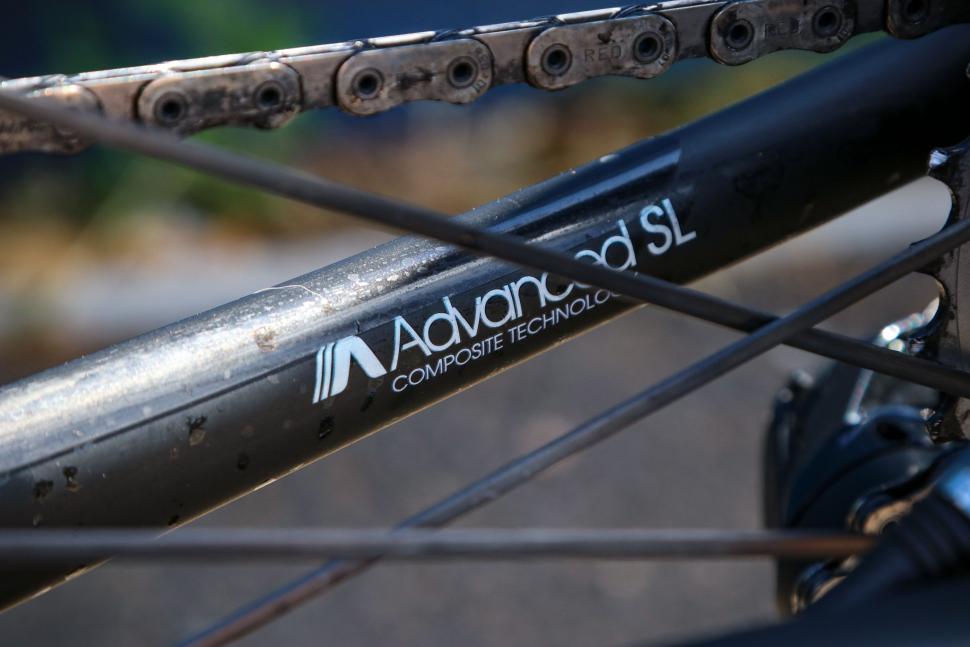

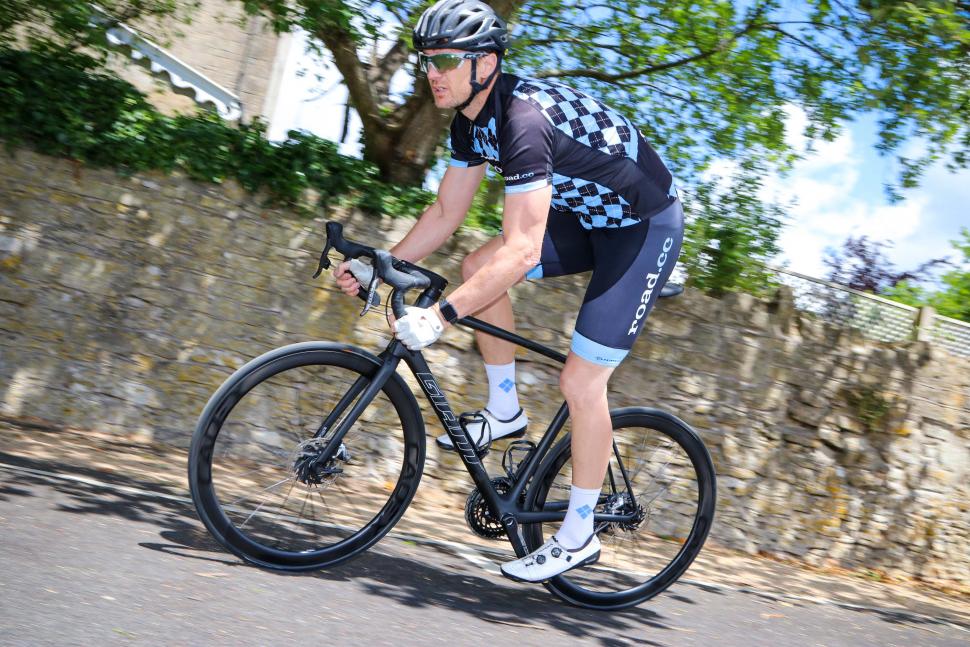





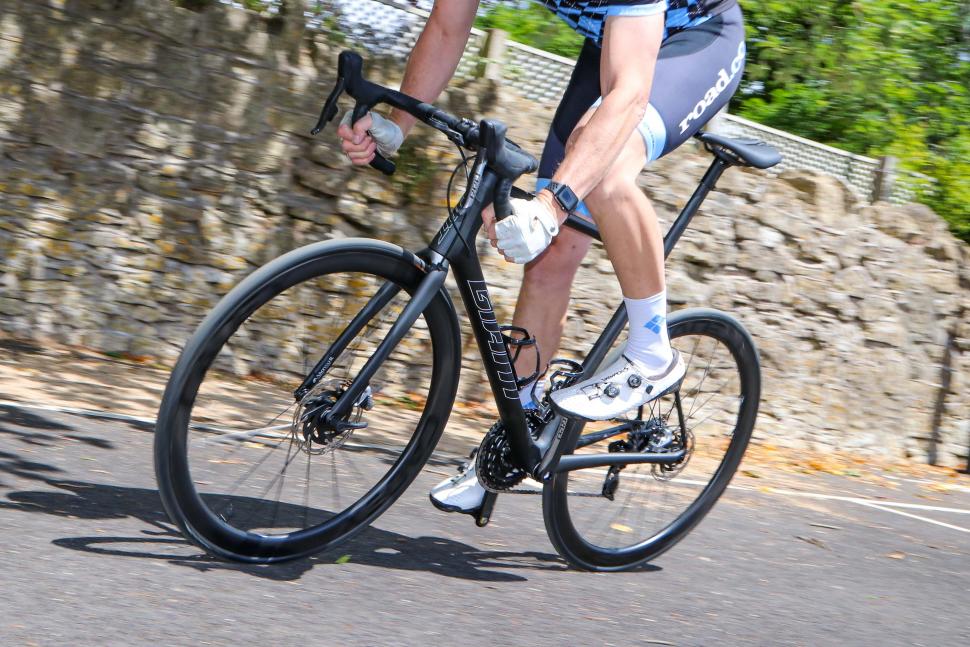









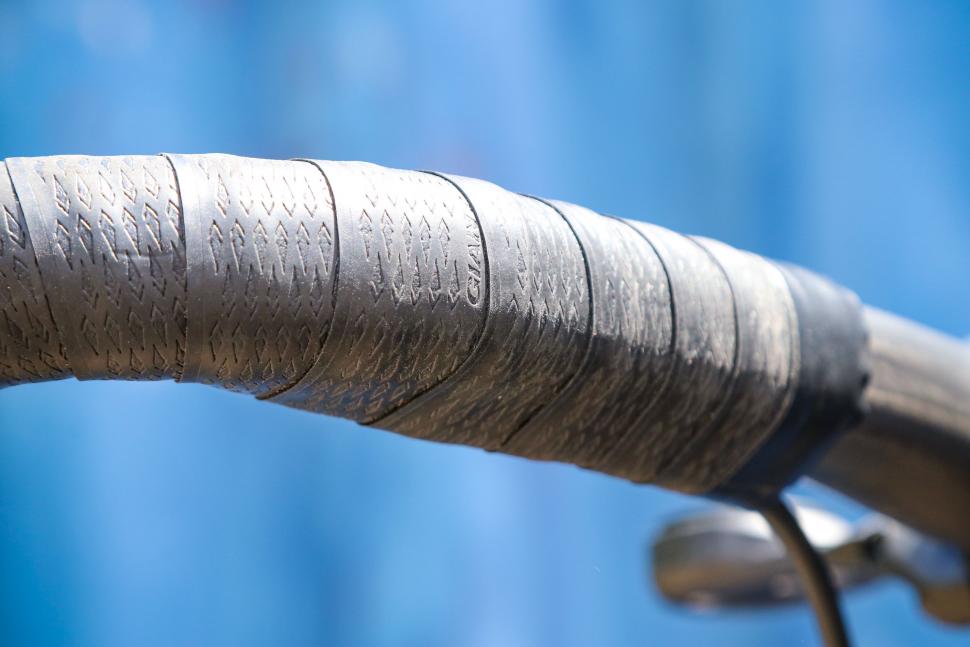





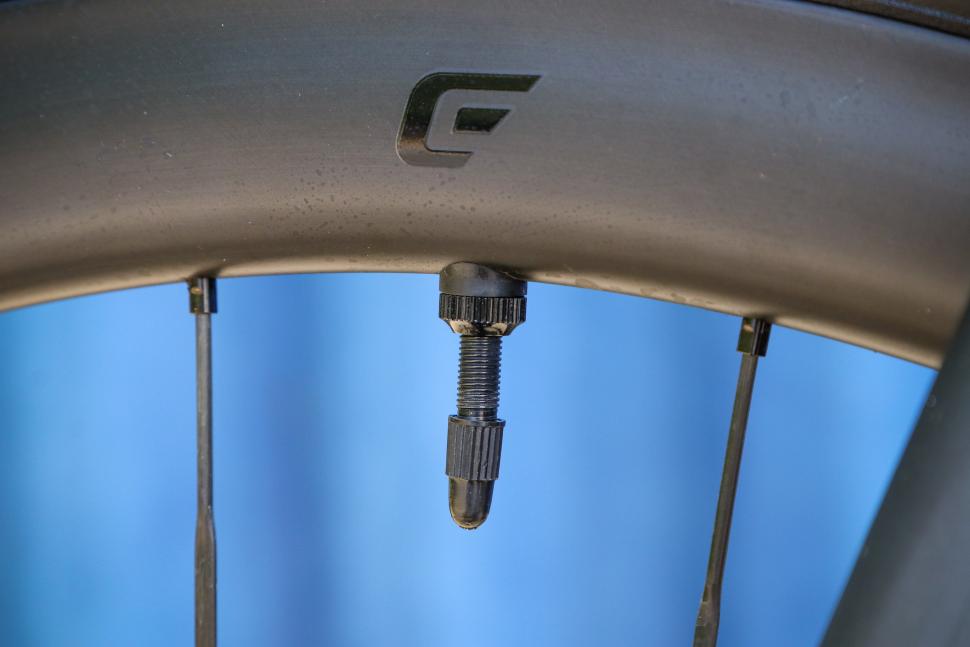





Add new comment
3 comments
Can you fly with it ? I had one of the old TCRs and it was a great bike - but the new high seat tube makes me wonder if it would fit in a bike box/bag ?
A great review, I enjoyed reading that.. it sounds like an awesome bike!
Great in depth review, liked the more detail on geometry. I'll call Giant out and say if you're going to release a 10k bike it has to have a cool integrated modern cockpit. If you have the cash to spend 10 thousand on a bike, ease of maintenance is not top of the list - You have a guy for that (LBS).
Good decision to ditch Shimano for the top end, nothing wrong with Shimano but it's bog standard stuff.